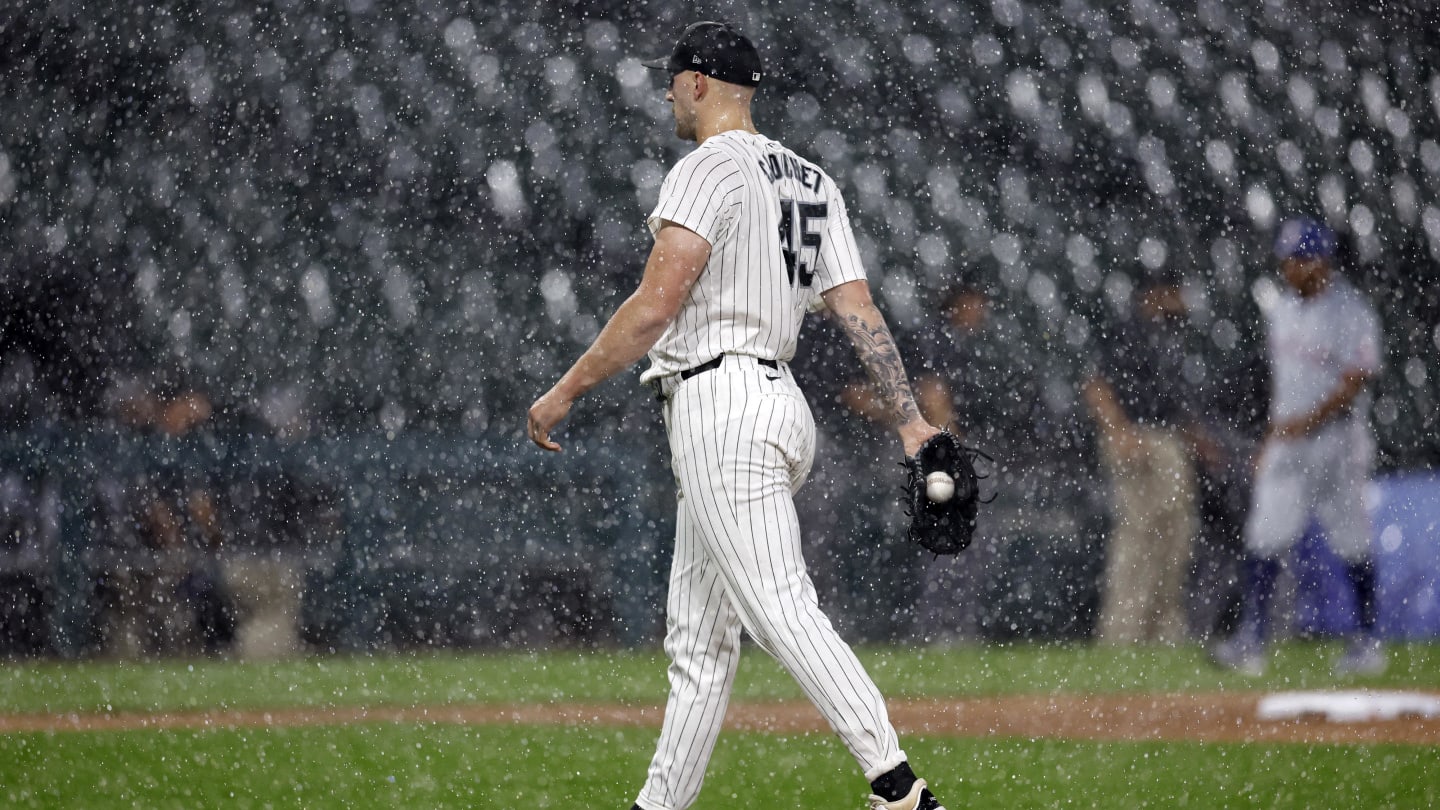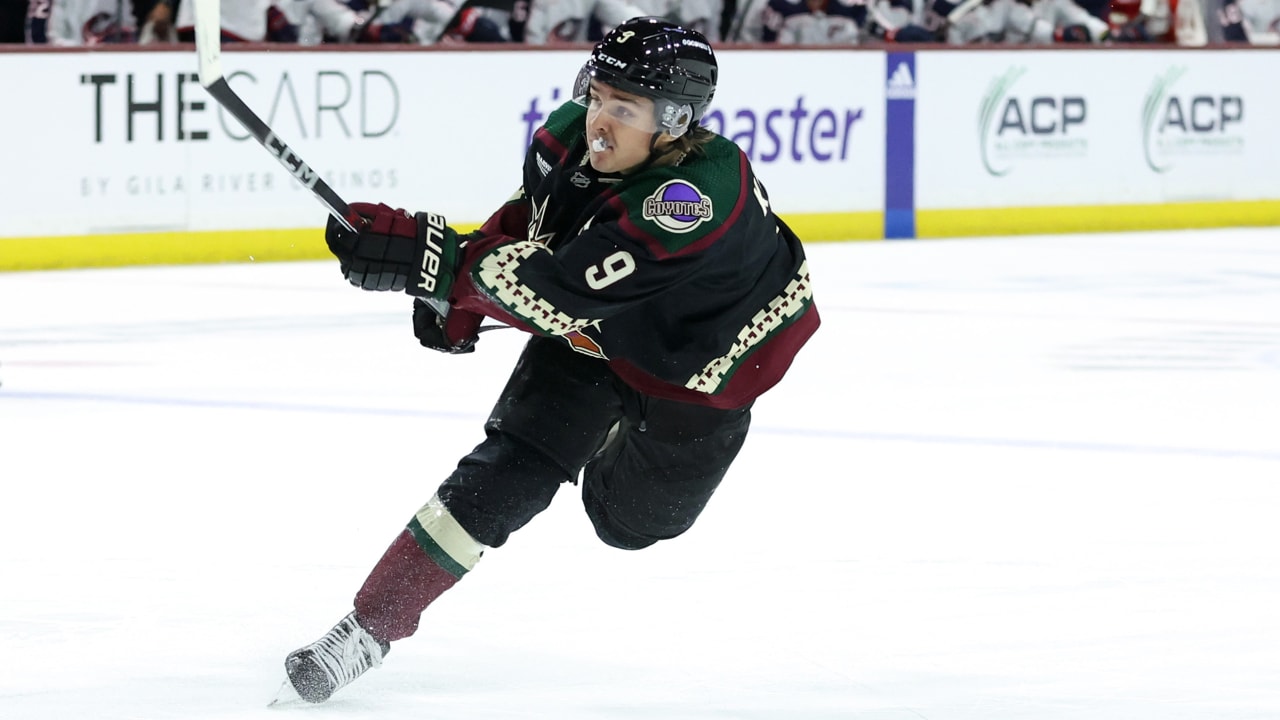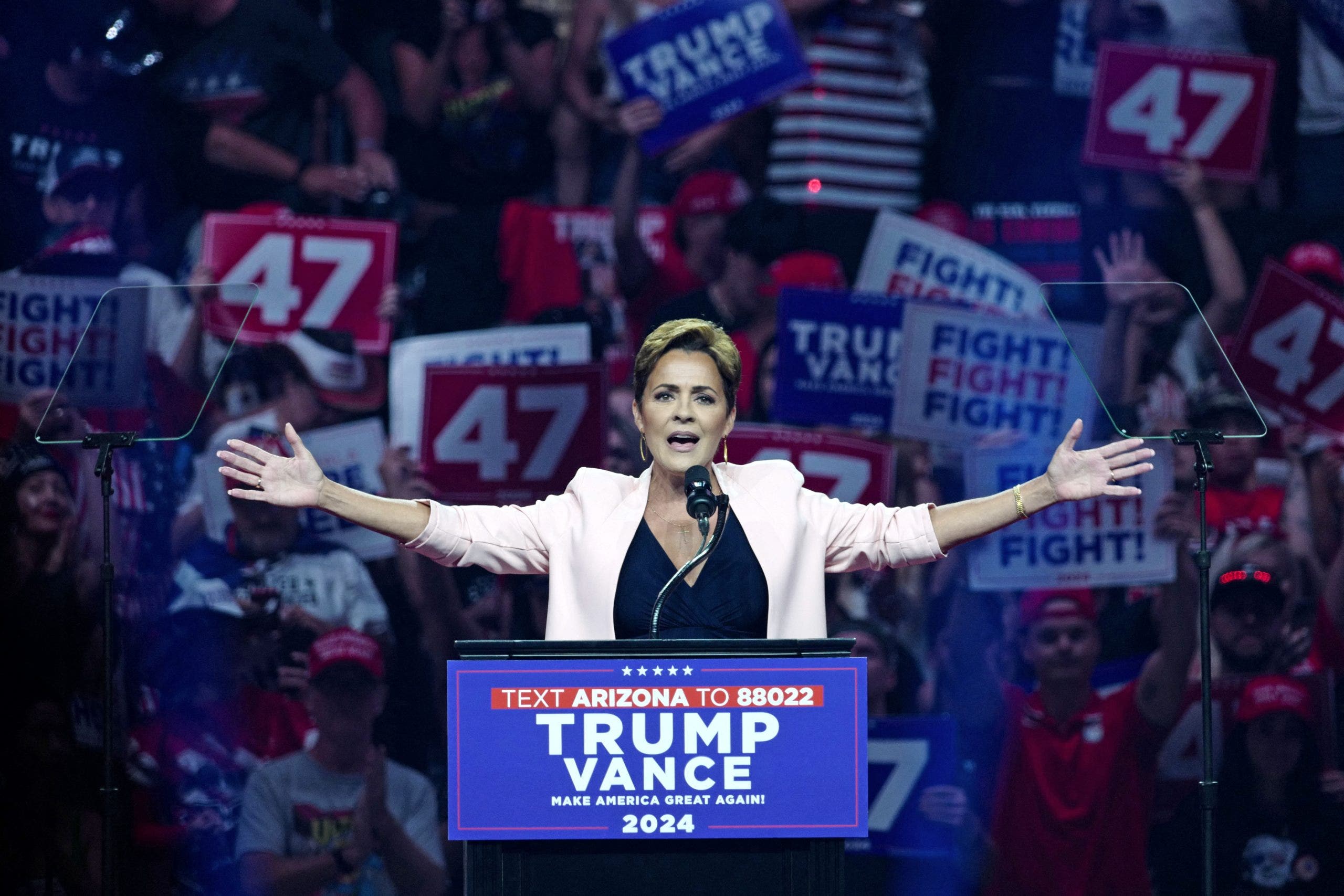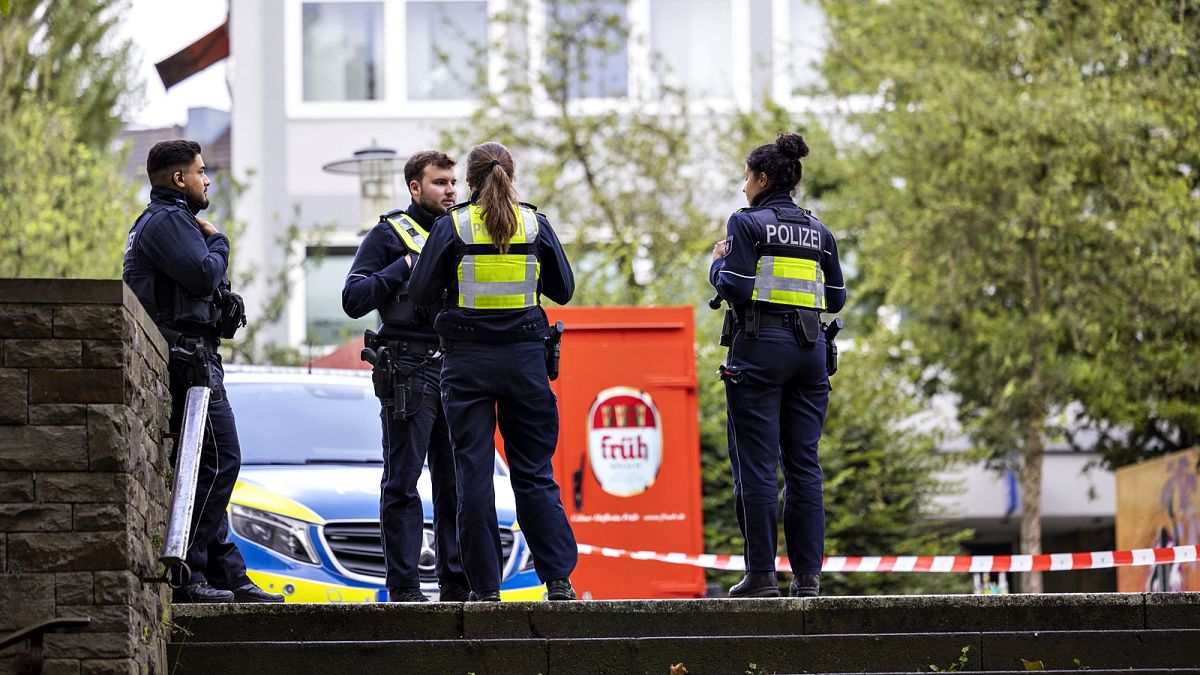Sports
Matthew Stafford's wife Kelly Stafford offers Taylor Swift, other WAGs pointed advice: 'Don't lose yourself'
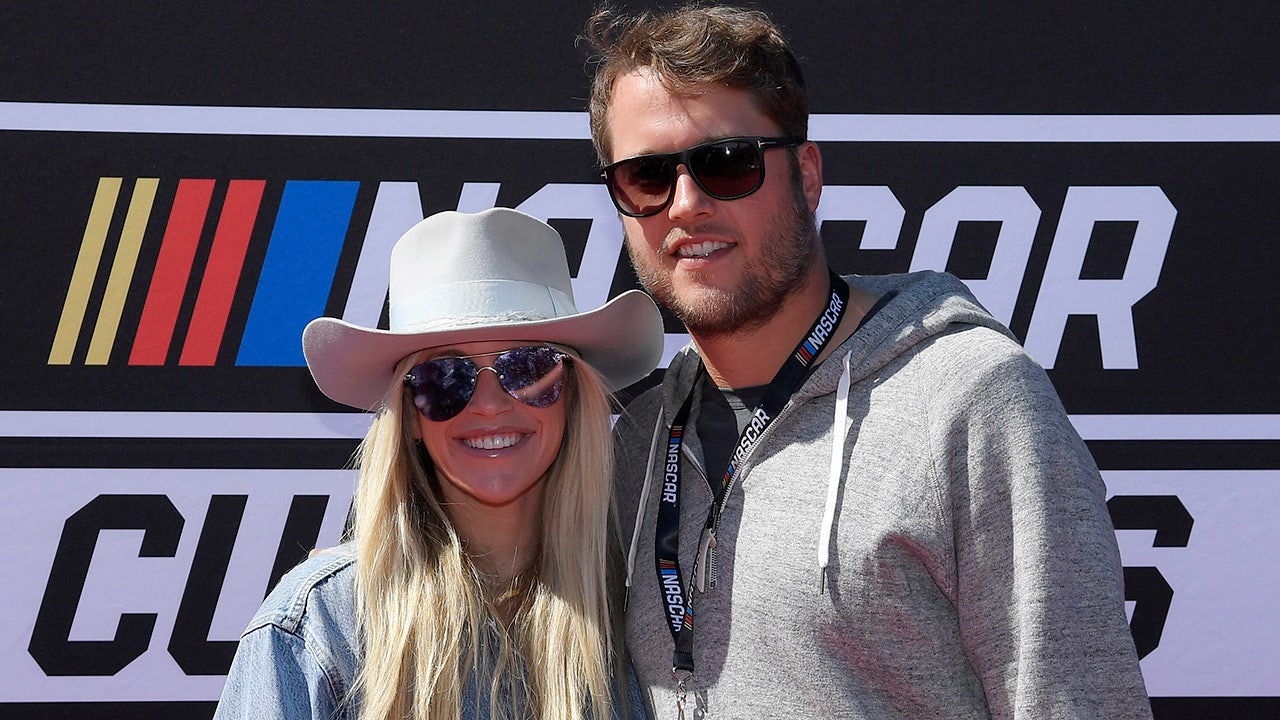
Over the past decade and a half, Kelly Stafford has learned the ins and outs of what comes with having a partner who plays in the NFL.
Kelly, who is married to Los Angeles Rams quarterback Matthew Stafford, has described herself as the “elder football wife.” Her husband will soon begin his 16th season in the league, and she is now offering some advice to her fellow NFL WAGs (wives and girlfriends), specifically Brittany Mahomes and Taylor Swift.
Brittany is married to three-time Super Bowl champion Patrick Mahomes. Swift, the 14-time Grammy winning pop sensation, became romantically linked to Mahomes’ teammate Travis Kelce last season.
Super bowl champion quarterback Matthew Stafford #9 of the Los Angeles Rams and his wife and Kelly pose on the red carpet before the start of NASCAR Cup Series Wise Power 400 at the Auto Club Speedway on February 27, 2022 in Fontana, California. (Kevork Djansezian/Getty Images)
“I think they have their things pretty settled and know where they are in life,” Stafford told E! News. But, she also cautioned that she might not be the best messenger, citing her previous missteps. “I’ve messed up so many times,” but she’s willing to heave up some truths,” Stafford added.
MATTHEW STAFFORD’S WIFE APOLOGIZES FOR ‘MEDIA STORM’ AFTER REVEALING SHE DATED HUSBAND’S BACKUP QB
Nevertheless, she did offer her fellow football wives and girlfriends some advice. “Something that I wish someone would have told me coming into this is, ‘Don’t lose yourself,’” she shared.
“I would say, ‘Don’t try to become the person that everybody else wants you to become,’” she continued. “Because that’s what I did and I lost who I was. And that goes with personality, looks, all of it.”

Los Angeles Rams quarterback Matthew Stafford (9) warms up during the Los Angeles Rams training camp on July 27, 2024, at Loyola Marymount University in Los Angeles, CA. (Jordon Kelly/Icon Sportswire via Getty Images)
The Stafford’s tied the knot in 2015 and share four daughters.
Stafford added that it is important for wives and girlfriends to do their best to block out as much of the noise as possible.

Los Angeles Rams’ quarterback Matthew Stafford kisses wife Kelly Stafford after winning Super Bowl LVI between the Los Angeles Rams and the Cincinnati Bengals at SoFi Stadium in Inglewood, California, on February 13, 2022. (FREDERIC J. BROWN/AFP via Getty Images)
“You’re going to have everyone telling you what you should look like, what you should say and not say, all of these things,” added the Georgia native. “And if you start listening, you lose the values and everything you have that makes you who you are, and makes you the person your husband fell in love with.”
“You can’t cancel out all the noise,” she admitted, “but try to listen to yourself before you listen to anybody else.”
Kelly co-hosts “The Morning After” podcast along with her friend Hank Winchester.
Matthew spent the first 12 years of his career with the Detroit Lions. While the podcast does occasionally touch on football, Stafford and Winchester tackle a wide range of other topics, including navigating friendships and parenting. “I’m very vulnerable throughout this podcast,” explained Kelly, “because I feel safe in this community, which is why I love it.”
Follow Fox News Digital’s sports coverage on X, and subscribe to the Fox News Sports Huddle newsletter.

Sports
We know more about quarterbacks’ arms than ever. Can NFL teams take advantage?

When Buffalo Bills star Josh Allen comes across YouTube clips of himself throwing passes for the University of Wyoming, he swears he doesn’t recognize that guy.
“It’s night and day in terms of the type of thrower I am,” Allen said this summer. “Where I held the ball, where I released the ball — it looks like a different guy. It’s kind of gross to look at sometimes. But I don’t think it’s as gross anymore.”
Allen, like many other NFL quarterbacks, spends time each offseason tweaking details of his throwing motion, “just trying to be as efficient as possible,” he said. And efficiency is the specialty of biomechanics experts such as Chris Hess, the founder of the 3D motion analysis company Biometrek.
A quarterback is a “rotational athlete,” one who rotates the body in order to throw, swing or hit. Hess and other specialists in the private sector specifically focus on the kinetic sequence, the transfer of energy during that rotation from the base of the body up through the arm.
An efficient thrower’s accuracy increases, biomechanists say, because his energy travels in the correct sequence: from legs to pelvis to torso to arm, with each reaching peak rotational velocity as the next begins. More efficient throwers also put less stress on their arms over time because the body properly produces and transfers the energy required to throw.
“Accuracy isn’t voodoo,” Hess likes to say, “it’s biomechanical science.”
Allen has worked with Hess and his motion-capture software since 2020 and believes this has helped make him a more accurate, controlled thrower. There is some evidence to support this. Allen’s completion percentage jumped from 52.8 and 58.8 in 2018 and 2019 to 69.2 percent in 2020 and has not dipped below 63 percent since (even while playing through a partially torn ulnar collateral ligament in his right elbow in 2022).
A rising number of NFL quarterbacks rely on independent professionals like Hess to incorporate biomechanics and its corresponding technology into their offseason training. Young stars like Allen, C.J. Stroud, Caleb Williams, Anthony Richardson and Brock Purdy have consulted with Hess to gather vast pools of data that tell them everything about how efficiently or inefficiently they throw using motion-capture technology.
After collecting and interpreting the data, Hess collaborates with physical therapists such as Dr. Tom Gormley to help them make body adjustments while private quarterbacks coaches such as Will Hewlett, Jordan Palmer and Adam Dedeaux fine-tune mechanics and technique. They develop injury prevention and recovery plans, pre-throw and post-throw routines and more — all with the hope of maximizing a quarterback’s arm, the tool that can make or break his career.
GO DEEPER
Building the perfect NFL QB: Meet the mysterious private coaches on the cutting edge
“It’s the most important position in all of sports, so you’re constantly evolving, trying to find ways to get mental reps, physical reps, without overdoing it,” said Bills GM Brandon Beane. “There is so much invested in that position that you are always looking for any area to improve to give your guys even the slightest advantage.”
Each spring, Hess travels the country to put quarterbacks through his motion capture programming at the request of their private coaches and occasionally NFL teams. His pack-and-go equipment, which uses high-resolution cameras to track movement rather than attaching sensors to the player, builds a perimeter of the cameras on a field like a super-sized imitation of a quarterback’s pocket.
The quarterback executes a range of spot throws from inside that pocket to establish a baseline. Once the system is calibrated, Hess has quarterbacks throw to receivers running a variety of routes. The quarterback can bootleg in and out of the perimeter of cameras, as the testing aims to simulate as many football movements as possible.
Streams of data emerge as the quarterback’s movement is translated by a computer into speed and energy outputs from every part of his body at each millisecond of every throw. Hess organizes the data into digestible pieces, including graphs and a visual display of the quarterback’s body as he throws — a skeleton frame with flashing colors that represent his energy transfer.
Hess and the physical therapists and private quarterbacks coaches he works with aren’t looking for massive issues. They emphasize the tiniest of adjustments that, over time, build the most efficient throwing motions possible.
“If you’re calling me, you’re ready for some granular information,” Hess said.

(Chris Hess / Biometrek)
For example, if a right-handed quarterback’s right leg extends even by a small degree before the pelvis starts to rotate — an issue common among throwers — that creates more forward momentum, not rotational momentum. Over time, such a movement puts more stress on the arm because the quarterback makes up for a lack of rotational energy by producing more effort with his shoulder/arm and tends to have less “feel” in his throw, which can turn into inaccuracy.
Once identified by Hess, the team of private specialists can introduce small, repetitive drills and exercises to correct the issue over weeks and months of offseason training.
“In 2020, when we first started working together, (Allen) felt like he had to rip every ball as hard as possible to get it to go where it was,” said Hess. “Whenever he had to throw something intermediate or short … he was kind of trying to de-accelerate his arm to slow the ball down to get touch. And it just made it so inconsistent.
“We gave him the information and helped him understand how to become rotational. Once he knew that, now Josh can speed up and slow down the ball with his body — the hand is just out there guiding the ball.”
Much of the science informing Hess and others comes from over a decade of research and application of biomechanics in baseball and golf.
“Baseball is pretty much light years ahead of the NFL as far as the ability to integrate sports science and also be data-driven,” said Dr. Emily Ferree, a physical therapist, biomechanist and movement specialist who consults for Major League Baseball teams, private quarterback coaches and NFL and college football players.
Baseball was an early investor in biomechanical application. There are dozens of “arms” in a given MLB team’s farm system, so huge amounts of data can be collected and studied each year, and technology and methods advance quickly as a result. The sport is even built to help keep that data clean. Pitchers may use different types of throws, but the ball is always thrown a specific distance from a specific spot on the field.
“There is a very repeatable, very controllable movement that you can test and measure (in a lab) that is almost identical to the performance environment,” Ferree said.
A quarterback can go into a play with a specific plan for his throw, but anything can happen after the snap to change that plan. What are his body and arm doing when he is scrambling away from pressure or suddenly opting to throw a sidearm pass while on the move in order to thread the ball between two defenders?
“There are so many things that happen in an NFL game that change the way the quarterback moves that it’s hard to do a singular throwing evaluation,” said Ferree. “That doesn’t mean that I don’t think it’s worth it. It gives us their baseline movement pattern — this is how your arm works, this is how it connects to your torso, this is how you generally transfer energy from your lower extremities to your upper extremities, this is how efficient you are, this is how (in)-efficient you are.”
Biomechanics-specific motion capture technology has proven useful in injury prevention and recovery. Ferree often sees quarterbacks try to “protect their elbow” as they return to throwing after a significant arm surgery (such as the UCL repair Purdy underwent in 2023, when he worked with Gormley and Hewlett throughout the recovery process). Their rotation changes — which has a ripple effect on the rest of their body.
“They just really aren’t efficient in their throwing motion,” Ferree said, “Motion capture in the rehab process can be huge because it allows you to track their arm path and basically tailor their throwing program to make sure they’re coming back as efficiently and as well as possible.”
The technology can also help quantify fatigue. Biomechanics experts can now see exactly when a thrower begins to wear down because they can measure micro changes in their transfer of energy. From there, experts can plan the quarterback’s ideal workload through the course of a practice week.

(Chris Hess / Biometrek)
Many NFL strength and conditioning and medical staffs collaborate with quarterbacks using data gathered from private offseason specialists to formulate an overall plan for injury recovery, arm maintenance and workload management. But the investment in sports science, medical and conditioning staffs and technology varies among the 32 organizations.
Some owners are simply willing to spend more money in that area than others. Plus, the NFL can be a hard environment for experimenting with new data and technology — some teams feel there is not enough time or comfort to try new things while maintaining care for a 90-man offseason roster and 53-man in-season roster.
Some quarterbacks want more than teams can offer — or simply feel more comfortable working with specialists where they can receive niche programming. At times, there have been highly publicized rifts between a quarterback and his independent coaches on one side and the organization on the other (think Tom Brady and Alex Guerrero chafing against Bill Belichick in the mid-2010s) that have given owners pause when working with the private sector.
Bridging the gap between those specialists and an NFL team requires balance. NFL teams have to look at the entire roster when choosing which technologies they champion and which experts they employ. Certain quarterback-specific practices, for example, are of no use to the rest of the players on the roster. A sports performance director, and ultimately a team’s owner, decides whether an investment is worth it or not.
A team could hire a quarterback-focused biomechanist and invest in its own motion capture technology, similar to the model of many MLB teams, but what other role would that person hold in an NFL building? The work done by private specialists includes making tiny adjustments to how a player throws and his workload to maximize arm strength and preserve its health. Would that bump up against the work of NFL team’s quarterbacks coach? It might not matter — quarterbacks coaches in some buildings are more focused on game planning and play installation during the season and less on actual player development.

Free, daily NFL updates direct to your inbox.
Free, daily NFL updates direct to your inbox.
Sign Up
Turnover also works against the full implementation of biomechanical data and training methods. Gathering enough data to turn into useful applications can take years. A lack of continuity at head coach and in the front office can sometimes mean the same in a team’s athletic training and sports medicine departments.
Some teams outsource biomechanical work, especially for quarterbacks. In that case communication with the quarterback about the data gathered from his offseason training — and an understanding of how to apply it from late July to February, when the player is with the team — is crucial.
“We are in an unprecedented time with this steep curve of technology coming out so fast — more than we probably can ingest it, to be honest,” said Tyler Williams, the Minnesota Vikings’ VP of player health and performance. “That gets a little dangerous. You’re trying to figure out, ‘How do we filter out the noise’?”
Under Williams, the Vikings test certain technologies throughout the year, accumulating data in as real a football environment as possible and studying the results over a long time. The team puts accelerometers in its practice footballs to measure changes in velocity, rotation and distance. They match those changes with movement trackers that assess energy output and stress on the body and parse this in combination with motion capture software and practice film.
The idea is to see what patterns might emerge regarding how players expend energy, the effect of certain movements and drills on the body and more.
“You’re pairing biomechanical (study), motion capture, different variables. It gives you a way further granular picture of how the quarterback moves (and) what makes them successful,” Williams said.
“You’re building a picture with puzzle pieces. In 1985, we were using the little kid puzzles that had eight pieces. … Eventually, with mobile motion capture, accelerometers, on-field player tracking from RFID technologies, force plate technologies — all of these different types of entities — we can measure the athlete (with), now we’re probably playing with a picture that is like, a 500-piece puzzle.”

Rams QB Matthew Stafford flips a sidearm pass during the playoffs last season in Detroit. (David Reginek / USA Today)
Like the Vikings, the Rams’ sports science department — once led by Williams and now by Trent Frey, who spent the last six years in a similar role with the NHL’s Los Angeles Kings — places sensors in the practice footballs. The Rams also collect movement tracking data for the entire roster and can quantify energy output per movement, which helps when building workload management plans for players.
Frey and the Rams’ medical and strength and conditioning staff then work with coaches to script out practices and weight room periods. The idea is to get every player as individualized a plan as possible while keeping a team atmosphere intact. The quarterback will not have the same weight training and injury prevention programming as a receiver, who will not have the same programming as a defensive end and so on.
It wasn’t so long ago, said Rams director of strength and conditioning Justin Lovett, that NFL quarterbacks protested getting pulled off of “the main lift” (the group weight training session) in the interest of more specialized training.
“There was a little bit of a culture shock,” Lovett said. “The coaches and the quarterbacks would say, ‘I need my guys to see us work.’ … Sometimes that would cut at the grit or the culture that your head coach is trying to establish.”
Lovett wants to blend the months of independent offseason training and biomechanics work into a much tighter NFL ramp-up period in the spring. “It’s really accessing that network and then carrying where they left off,” he said.
When Hess works with quarterbacks, he runs them through a final motion capture session right before OTAs, and the player’s team receives the results. From there, Gormley or another specialist can explain what adjustments he and the player’s private coach made, what warmup and recovery exercises they implemented — and show exactly why using Hess’ data.
With the Rams, Gormley went a step further. Lovett hosted him for two days this spring at their practice facility in Thousand Oaks, Calif., to talk to the strength and conditioning and sports performance staff about biomechanics and the physical application of available technology.
Lovett believes the private sector has gotten so advanced that it can give an open-minded team an edge in building out its quarterback’s in-season training plan. External specialists and the quarterbacks they work with in the offseason have more information about a thrower’s arm than ever before.
As investments into the position increase by millions each year, figuring out how to best tap into that information year-round might be NFL teams’ next advantage.
(Illustration: Dan Goldfarb / The Athletic; photos: Robin Alam / ISI Photos, Brian Rothmuller / Icon Sportswire via Getty Images)
Sports
Flag football QB who said he's 'better than Patrick Mahomes' dominates at world championships
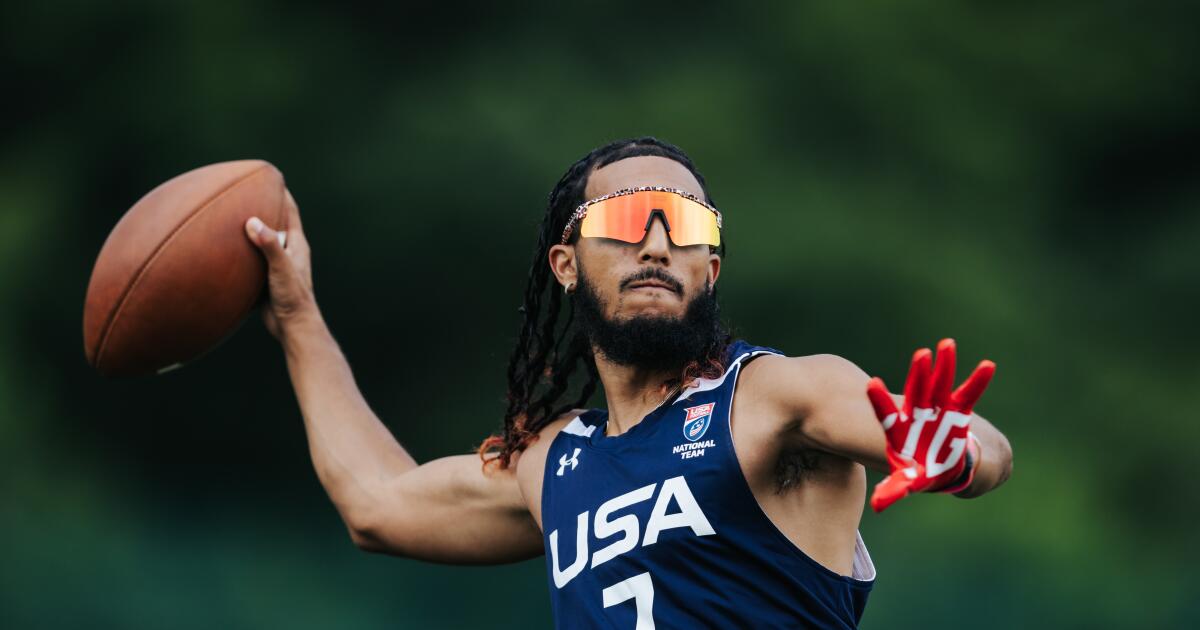
Maybe Darrell Doucette isn’t delusional after all.
Perhaps the quarterback known as “Housh” was correct last week when declared that he’s “better than Kansas City Chiefs superstar Patrick Mahomes” — at least when it comes to flag football.
Mahomes is three-time Super Bowl champion and two-time NFL MVP. Doucette hasn’t played in the NFL but is a superstar in the flag football community, as he is continuing to prove this week at the International Federation of American Football Flag Football World Championships in Lahti, Finland.
The U.S. began its defense of the world title it won in 2022 with a strong showing Tuesday as group play began, with a 57-25 win over Spain and a 52-6 win over Brazil. Over the two games, Doucette completed 15 of 19 passes for 281 yards and eight touchdowns. He also ran for a touchdown and added another as a receiver.
U.S. quarterback Darrell Doucette scores a touchdown as a receiver during a 52-6 win over Brazil during group play at the IFAF Flag Football World Championships on Tuesday in Lahti, Finland.
(Lester Barnes / USA Football)
The U.S. finishes group play against Serbia on Wednesday.
Earlier this month, Doucette told the Guardian he feels it’s “disrespectful” to the flag football community to “automatically assume” that NFL players will be the ones to represent the U.S. when the sport makes its Olympic debut at the 2028 Los Angeles Games.
He elaborated last week in an interview with TMZ.
“We are fans of these guys, and like I said, we love the fact that they wanna go out and win the gold medal and represent the country, just like us,” Doucette said. “But we don’t want to be forgotten about because we are the ones who helped this game get to where it’s at.”
He also mentioned that he might be a better option at quarterback than Mahomes, one of several NFL players who have expressed interest in playing flag football at the Olympics.
“I feel like I’m better than Patrick Mahomes because of my IQ of the game,” said Doucette, who led the U.S. to victory at the 2021 IFAF World Championship in Jerusalem, the 2022 World Games in Birmingham, Ala., and the 2023 IFAF Americas Championship in Charlotte, N.C.
“I know he’s right now the best in the league, I know he’s more accurate, I know he has all these intangibles. But when it comes to flag football, I feel like I know more than him.”
Sports
The unbearable misery of Everton – the Premier League’s bleakest club

Euston station in London is a bleak place at the best of times. Claustrophobic, harshly lit and always overcrowded, nobody wants to be there for longer than is absolutely necessary.
It was thus a fitting venue for a group of Everton fans to harangue their team’s players as they boarded a train back to Merseyside after their 4-0 defeat to Tottenham at the weekend. “F***ing rat” was one of the choicer epithets that could be heard on a clip that went viral at the weekend.
The footage raised conflicting thoughts. On the one hand, it was tough not to agree with the club’s striker Neal Maupay — one of the primary targets for the abuse — when he posted on X: “Imagine another job where it’s normalised to get abuse like this. Hanging around at a train station to scream at men who are trying their best.”
It is only two games into the new season and they are not deliberately trying to lose.
Neal Maupay was the subject of abuse on Saturday (Charlotte Tattersall/Getty Images)
Yes, the players are paid huge amounts of money, but the numbers on their wage slips are reflections of their athletic and mental abilities relative to the finances of the industry they are in, not a measure of how many swear words you can hurl at them while they are boarding a train. By Monday morning, Everton fan groups were queuing up to condemn the scenes.
On the other hand, there will be plenty of people out there who, maybe in a very small way, identify with those Everton fans. Sometimes you have a lot of rage and frustration and you don’t know what to do with it. Those Everton supporters should not have reacted the way they did, but when you are at the end of a long, expensive and disappointing day, and the sources of that disappointment wander past, it’s easy to see how rage can drown out the better angels of your nature.
The reaction isn’t just about one game either. You could make a strong argument that Everton are the bleakest club in the Premier League — and have been for some time, given all of the problems swirling around them.
We’ll take on-the-pitch stuff to start. They have lost their first two games of the season by an aggregate score of 7-0. It is the first time in their history that they have lost both of their opening games by three or more goals. Only Everton and Southampton are yet to score in this season’s Premier League. Everton have had only two shots on target, which is the lowest in the division, and a much-trumpeted final season at Goodison Park began with a defeat to Brighton that saw the stadium half-empty by the time the final whistle blew.

Goodison Park was largely empty by the time the Brighton game ended (Carl Recine/Getty Images)
Dominic Calvert-Lewin, despite his run of goals towards the end of last season, continues to be nothing like his best. Beyond him, they have only Maupay and Beto as centre-forward options, albeit Iliman Ndiaye will potentially be threatening from a slightly deeper role. Their full-back options are shallow, they look light in central midfield and they will be praying Jordan Pickford’s error at the weekend is a blip rather than a sign that his capabilities are waning. Saturday’s game against Bournemouth is, absurdly for the third fixture of the season, already looking massive.
But that’s nothing compared to the off-pitch stuff. The sale of Amadou Onana to Aston Villa should set aside any immediate concerns over a third points deduction related to profitability and sustainability rules, but you never know what gremlins lurk in their books.
More of a worry is Everton’s ownership situation. Fans have been protesting the regime of owner Farhard Moshiri for years. It is a relief that they didn’t end up in the hands of 777 — the Miami-based investment firm that The Athletic pointed out in June had been “described as a ‘house of cards’ in one lawsuit and a ‘Ponzi scheme’ in another” (claims 777 denies) — but the mess left by that protracted takeover saga spooked the Friedkin Group, a slightly more reputable potential custodian.
As Matt Slater reported in July, the Friedkins got cold feet because of legal uncertainties surrounding the £200million ($260m at current rates) that former Everton suitor 777 Partners has lent to the club over the past year.
Moreover, even though Dan Friedkin didn’t acquire the club, he still lent them a further £200million to pay a bill from the constructors of their new stadium at Bramley-Moore Dock. So the next suitor that comes along not only has to unpick the ball of wool that is their finances, but also has to contend with two sizeable loans to previous prospective owners — loans that will need to be paid back at some point.
They’ve managed to find themselves in a Groucho Club situation: it’s such a mess that anyone you would want to own your club is probably too sensible to go anywhere near them.

Everton fans have been protesting at the running of their club for years (Lewis Storey/Getty Images)
Their best hope appears to be John Textor, but even if he manages to divest his stake in Crystal Palace — which, for financial and regulatory reasons, he needs to do to buy Everton — he’s not exactly a knight in shining armour. The most generous description of his record with his other clubs is ‘patchy’: a less generous interpretation is that his clubs tend to end up in varying degrees of chaos.
Belgian side Molenbeek were relegated last season, Lyon’s men’s team were in danger of the same in 2023-24 until a superb second half of the campaign and Palace’s progress has been stop-start since his arrival as a shareholder in 2021.
Even the success stories come with an asterisk: Botafogo are second in the Brazilian Serie A, just one point off the top after 24 games, but collapsed spectacularly when well placed in the title race last season. Textor subsequently made a series of match-fixing and corruption allegations that were rejected by the Superior Tribunal de Justica Desportiva, the autonomous legal arm of Brazilian football, funded by the country’s football federation.
Ultimately, if Everton fans were to choose their ideal owner, it wouldn’t be Textor. He just looks preferable to some of those who have kicked the tyres over the past year or so.
Sean Dyche summed it up more succinctly after the defeat to Tottenham: “There’s so much noise and stories every day around Everton and it is tough. It’s not very often about the football.”

GO DEEPER
Everton’s start is breeding anxiety, apathy and anger
There are some reasons to be cheerful. They also lost their first two matches of the previous two seasons and were ultimately fine. They have an excellent manager who specialises in defying expectations, whose entire career has essentially been one long middle finger to people who have written him off. They have, at the time of writing, managed to keep Jarrad Branthwaite, a genuinely excellent and homegrown (mostly — he signed from Carlisle United when he was 17) defender that plenty of big teams have already been sniffing around and more will do so in the future. All being well they will be in a new, modern, picturesque stadium this time next year.
But those rays of hope are having to work hard to pierce the fog of despair at the moment. If you search ‘Everton dejected’ in the Getty Images database, it comes up with 4,563 results. And not all of them are Pickford.
At the start of the season, The Athletic ran a survey to gauge the hopefulness levels of each Premier League club’s fans. According to that, 76 per cent were more optimistic about the season ahead than pessimistic.
You wonder how different that will be now.
(Top photo: Marc Atkins/Getty Images)
-

 Minnesota1 week ago
Minnesota1 week agoReaders and writers: Plenty of thrills and danger in these Minnesota author’s mysteries
-
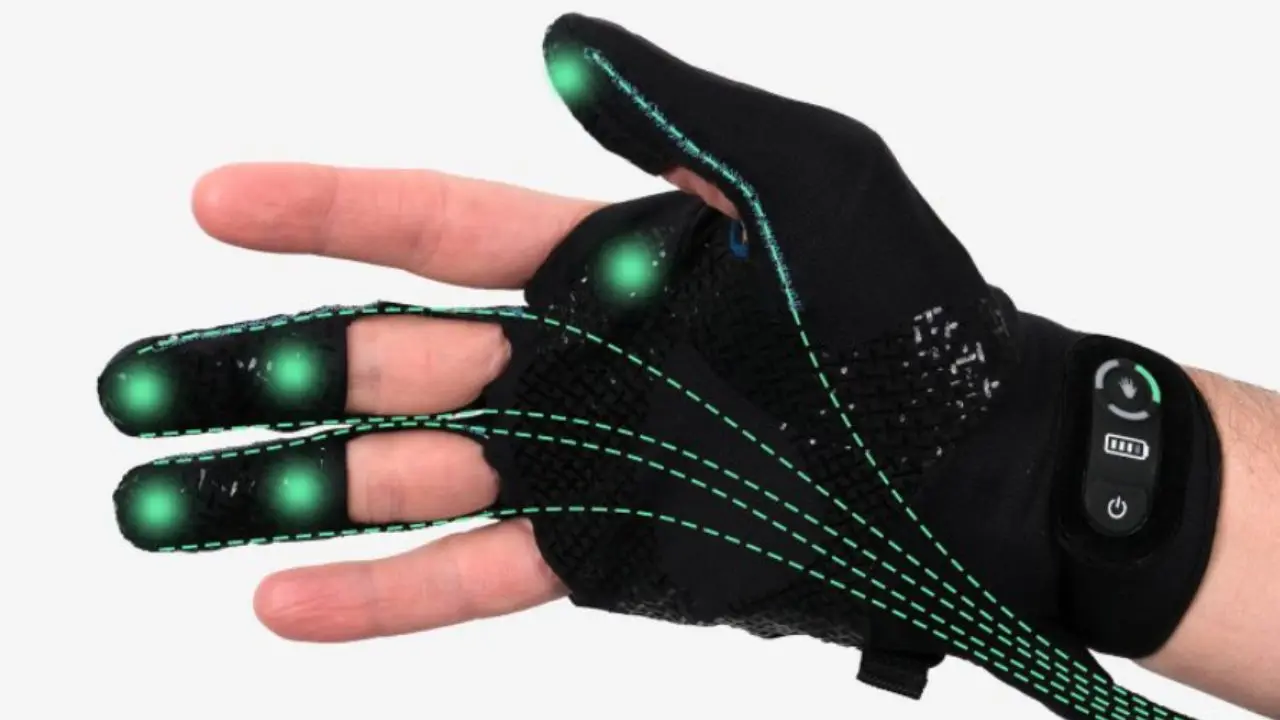
 Technology6 days ago
Technology6 days agoBreakthrough robo-glove gives you superhuman grip
-

 News1 week ago
News1 week agoVideo: Biden Delivers Keynote on First Night of D.N.C.
-

 Connecticut4 days ago
Connecticut4 days agoOxford church provides sanctuary during Sunday's damaging storm
-

 News1 week ago
News1 week agoVideo: Protesters Clash With Police Near the Democratic National Convention
-

 World1 week ago
World1 week agoNigeria police working to secure release of 20 kidnapped medical students
-
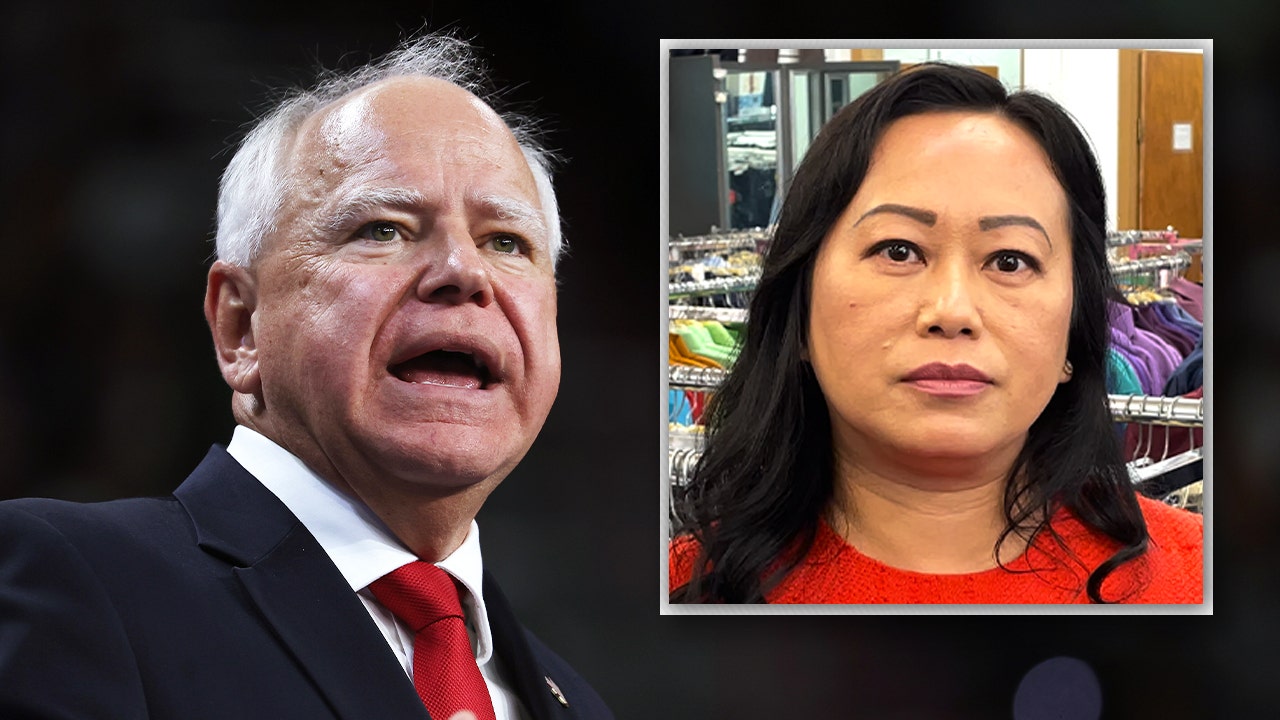
 Politics1 week ago
Politics1 week agoFormer teacher reveals which students suffered 'the most' under Walz's pandemic-era guidelines
-
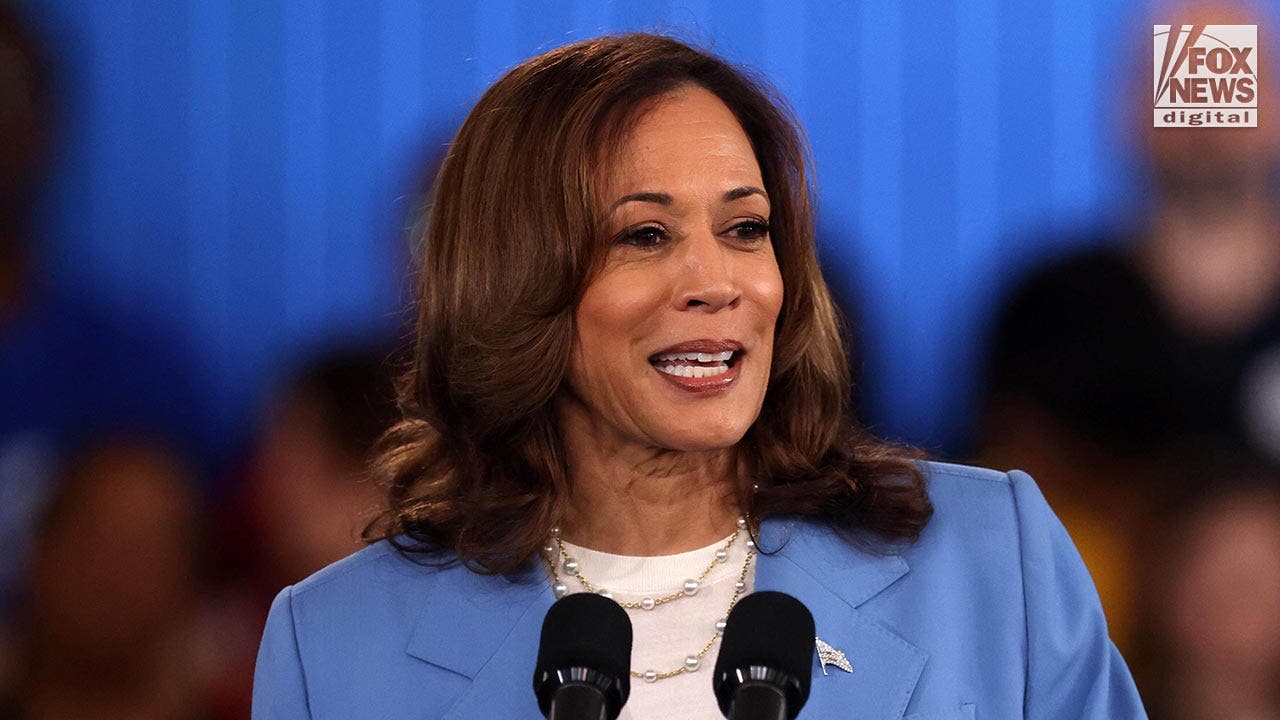
 Politics1 week ago
Politics1 week agoDem strategists say Harris needs to ensure she's 'striking the right balance' at DNC, seize on 'momentum'


